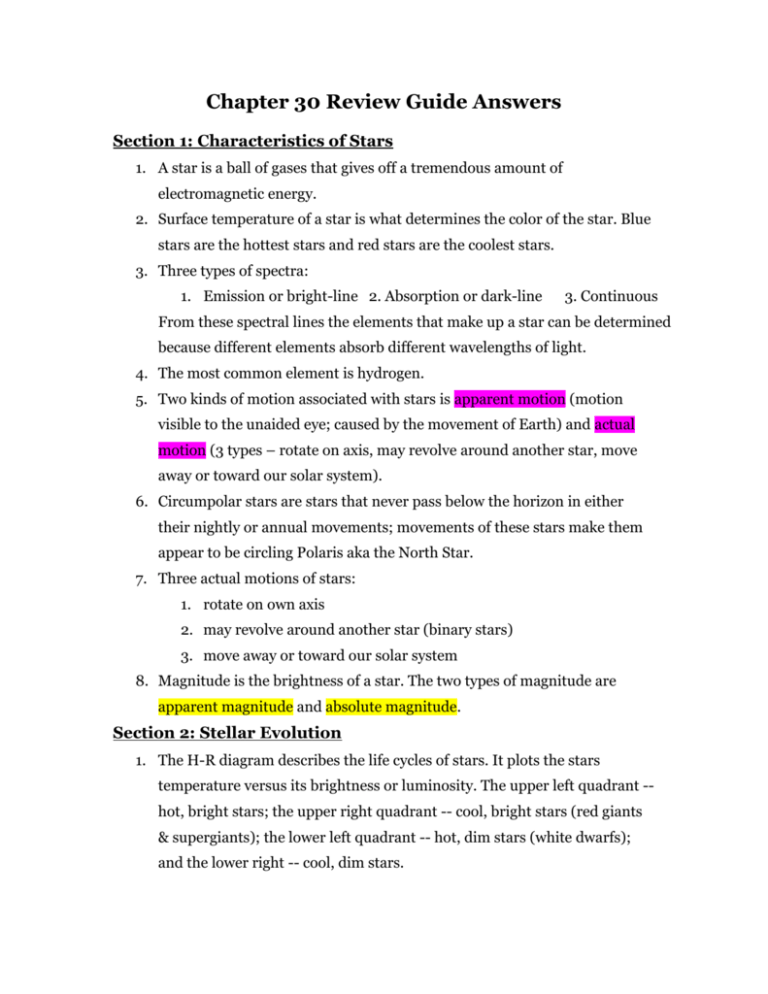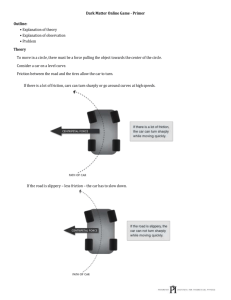Astronomy Review Guide: Stars, Galaxies, and the Big Bang
advertisement

Chapter 30 Review Guide Answers Section 1: Characteristics of Stars 1. A star is a ball of gases that gives off a tremendous amount of electromagnetic energy. 2. Surface temperature of a star is what determines the color of the star. Blue stars are the hottest stars and red stars are the coolest stars. 3. Three types of spectra: 1. Emission or bright-line 2. Absorption or dark-line 3. Continuous From these spectral lines the elements that make up a star can be determined because different elements absorb different wavelengths of light. 4. The most common element is hydrogen. 5. Two kinds of motion associated with stars is apparent motion (motion visible to the unaided eye; caused by the movement of Earth) and actual motion (3 types – rotate on axis, may revolve around another star, move away or toward our solar system). 6. Circumpolar stars are stars that never pass below the horizon in either their nightly or annual movements; movements of these stars make them appear to be circling Polaris aka the North Star. 7. Three actual motions of stars: 1. rotate on own axis 2. may revolve around another star (binary stars) 3. move away or toward our solar system 8. Magnitude is the brightness of a star. The two types of magnitude are apparent magnitude and absolute magnitude. Section 2: Stellar Evolution 1. The H-R diagram describes the life cycles of stars. It plots the stars temperature versus its brightness or luminosity. The upper left quadrant -hot, bright stars; the upper right quadrant -- cool, bright stars (red giants & supergiants); the lower left quadrant -- hot, dim stars (white dwarfs); and the lower right -- cool, dim stars. 2. The size of the star determines which path in the diagram above it will follow. 3. The nuclear process that fuels the life of a star is nuclear fusion (Hydrogen fuses together to make helium; the onset of fusion marks the birth of a star). 4. Characteristics of giant stars: glow with a reddish color, large stars, they are bright because of their large surface area; stars that contain about as much mass as the sun will become giants. Characteristics of supergiants: main sequence stars more massive than the sun will become supergiants; very bright (easy to find in night sky), found at the top right side of the H-R diagram, about 100 times larger than the sun, surface relatively cool. 5. Planetary nebula is a cloud of gas that forms around a sun-like star that is dying. 6. Nova – large explosions caused by pressure build-up on the surface of a white dwarf; the explosions release energy and stellar material into space. Supernova – a star that has such a tremendous explosion that it blows itself apart. 7. Pulsar – a very fast spinning neutron star that emits pulses of radio & optical energy. 8. Black hole -- an object so massive & dense that even light cannot escape its gravity. Section 3: Star Groups 1. A constellation is a group of stars that make a recognizable pattern. 2. Binary stars – Pairs of stars that revolve around each other and are held together by gravity. Barycenters – the center of mass in a system where the 2 stars have similar masses. 3. Three Types of star clusters: a. Star cluster – nebulas collapse to form groups of stars; possibly hundreds or thousands. b. Globular clusters – spherical shape; contains up to 100,000 stars. c. Open cluster – loosely shaped; rarely contains more than a few hundred stars. 4. Three types of galaxies: a. Spiral galaxy – most common type, nucleus of bright stars and flattened arms that spiral around the center. b. Elliptical galaxy – vary in shape from nearly spherical to very elongated like a stretched out football. c. Irregular galaxy – has no particular shape; usually have low total masses and are fairly rich in dust and gas. 5. Characteristics of the Milky Way galaxy --- cloudlike band of stars that stretches across the night sky, milky appearance, spiral galaxy, sun is one of hundreds of billions of stars, each star orbits around the center of the galaxy, has a milky appearance. Section 4: Birth of a Theory: 1. The universe was determined by scientists using light to create the spectrum for a galaxy. They found that the spectra of galaxies were shifted toward the red end of the spectrum. By examining the amount of red shift, the speed at which the galaxies were moving away from the Earth was determined. 2. Big bang theory is that all matter and energy in the universe was compressed into an extremely small volume that 13 to 15 billion years ago exploded and began expanding in all directions. 3. Evidence that exists for the big bang theory: Background Radiation: Throughout the universe low level energy is distributed evenly. Formed shortly after the Big Bang Ripples --- These are irregularities in the cosmic background radiation; caused by small fluctuations in the distribution of matter st in the early universe; the ripples might also indicate the 1 stages in st the formation of the universe’s 1 galaxy. 4. Dark matter – matter that does not give off light, but has gravity that can be detected. Dark energy – All the unknown material in the universe.









